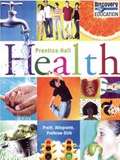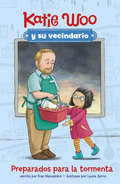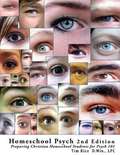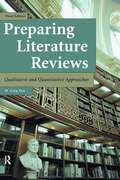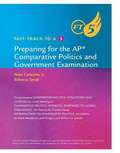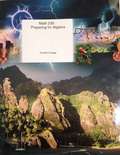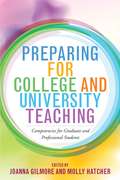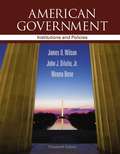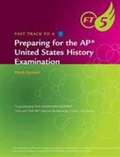- Table View
- List View
Prentice Hall: Health
by B. E. Pruitt John P. Allegrante Deborah Prothrow-StithNIMAC-sourced textbook
Prentice Hall: Mathematics, Course 2 (Virginia Edition)
by Prentice HallThis text will help you be successful on the tests you take in class and on high-stakes tests required by Virginia state. The practice in each lesson will prepare you for the format as well as for the content of these tests.
Prentice Hall: The Reader's Journey, Grade Eight
by PearsonThis guide explores The Reader's Journey, an innovative, novel-based language arts program designed for students in Grades 6-8. The Reader's Journey uses high-interest, leveled Anchor Books to engage students at their reading levels, and the program supports systematic development of core language arts skills.
Preparación para la evaluación de Texas [Grado 2] (¡Arriba la Lectura!)
by Houghton Mifflin Harcourt Publishing CompanyNIMAC-sourced textbook
Preparación para la evaluación de Texas [Grado 3] (¡Arriba la Lectura!)
by AvisoNIMAC-sourced textbook
Preparación para la evaluación de Texas [Grado 4] (¡Arriba la Lectura!)
by Houghton Mifflin Harcourt Publishing CompanyNIMAC-sourced textbook
Preparados para el futuro (¡Arriba la Lectura!, Level L #3)
by Reggie Holladay Stanford MakishiNIMAC-sourced textbook
Preparados para la tormenta (Katie Woo y su vecindario)
by Fran ManushkinSe acerca una tormenta, y Katie está preocupada. ¿Y si se quedan sin comida? La familia de Katie y sus amigos van a la tienda del Sr. Nelson a comprar provisiones y, de paso, aprenden una lección sobre la compra y venta. ¿Quién hubiera imaginado que allí aprenderían tantas cosas?
Preparation for Algebra: Math Advantage
by Harcourt BraceAfter a strategy has been chosen, a good problem solver then decides how to solve the problem. They think about whether using paper or pencil, a calculator, manipulatives, or mental math is the best way to get the answer.
Preparativos para un desastre natural (¡Arriba la Lectura!, Level T #40)
by Elsie Nelley Samantha AsriNIMAC-sourced textbook
Preparing Christian Homeschool Students For Psychology 101
by Timothy S. RiceHomeschoolPsych 2nd Edition: Preparing Christian Homeschool Students for Psych 101 and the accompanying Student Workbook are all a busy homeschooling mom (or dad) need. Prepare student to recognize the worldview assumption underlying modern Psychology s theories and schools-of-thought and introduce them to the study of God s greatest creation the human mind from a distinctly Christian perspective. Since the first edition was published in 2008, thousands of homeschoool students have used Homeschool Psych to study psychology from a Christian perspective.
Preparing For The Regents Examination: Algebra 2 and Trigonometry
by Ann Davidian Christine T. HealyA review book to accompany Amsco's Algebra Two and Trigonometry.
Preparing For The Regents Examination: Geometry
by Richard J. Andres Joyce BernsteinTo prepare students for the New York State Regents Examination, Geometry.
Preparing Literature Reviews: Qualitative and Quantitative Approaches (3rd Edition)
by M. Ling PanThis book covers the basics for preparing both qualitative (i.e., narrative) and quantitative reviews. These do not constitute a dichotomy. Rather, literature reviews exist on a continuum from very highly qualitative (with little mention of statistics or the research methods used to obtain them) to very highly quantitative (with the final synthesis based on the mathematical averaging of results across various studies reported by different researchers).
Preparing for AP Comparative Politics
by Peter Caroddo Rebecca SmallThis book helps you review all of the material covered in an AP Comparative Government and Politics course and prepares you well for the AP Exam. AP Comparative Government and Politics is an exciting and engaging course, and there is no substitute for what you learn in the classroom.
Preparing for Algebra (Math Course 230 #Volume 2)
by McGraw-HillMathematics Course: Volume 2 Math 230: Preparing for Algebra
Preparing for Career Success Student Activity Book (3rd edition)
by Jerry Ryan Roberta RyanTogether with the Preparing for Career Success student textbook, the material in the Preparing for Career Success Student Activity Book addresses issues that are important as you prepare for the world of work. From completing a tax form to planning a weekly menu, you have the opportunity to practice important life skills as you think about the career and life issues you face as a young adult.
Preparing for College and University Teaching: Competencies for Graduate and Professional Students
by Molly Hatcher Joanna Gilmore"This book is a guide for designing professional development programs for graduate students. The teaching competencies framework presented here can serve as the intended curriculum for such programs. The book will also be an excellent resource for evaluating programs, and will be an excellent resource for academics who study graduate students"--Provided by publisher.
Preparing for Life and Career
by Louise A. Liddell Yvonne S. GentzlerPreparing for Life and Career gives students the tools they need to develop skills they can use throughout their lives and careers. Teens are challenged to learn how to develop and keep successful relationships, be a good family member, and contribute to their community. The responsibilities of child care, clothing care, and home maintenance--and how to handle them--are also presented. * Organized into 27 chapters presented as short, easy-to-read sections. * New chapter is devoted to transportation options. * Includes many new photos and charts to stimulate interest in learning more. * Interesting questions are posed throughout the text to encourage critical thinking and problem solving. * Common Core activities encourage the mastery of skills needed for college and career readiness. Other chapter activities promote Journal Writing opportunities, Technology applications, and FCCLA participation.
Preparing for a Natural Disaster (Into Reading, Level S #40)
by Elsie Nelley Samantha AsriNIMAC-sourced textbook.
Preparing for the AP Examination in United States Government and Politics
by Karen K. Waples David G. BensonPreparing for the AP Examination in United States Government and Politics is a student book whose goals are to help in reviewing the material learned as it offers a broad interpretation of the concept of study and in examination preparation.
Preparing for the AP United States History Examination
by David M. Kennedy Lizabeth Cohen Thomas A. BaileyThis book is keyed to The American Pageant, 13th and 14th editions and is compatible with all textbooks. This updated edition extends the history; the review goes up to the election of President Barack Obama, and the diagnostic and practice tests include multiple-choice questions about the 1990s and early 2000s.
Preparing for the AP® English Language and Composition Examination
by Steve Olson Eveline BaileyNIMAC-sourced textbook
